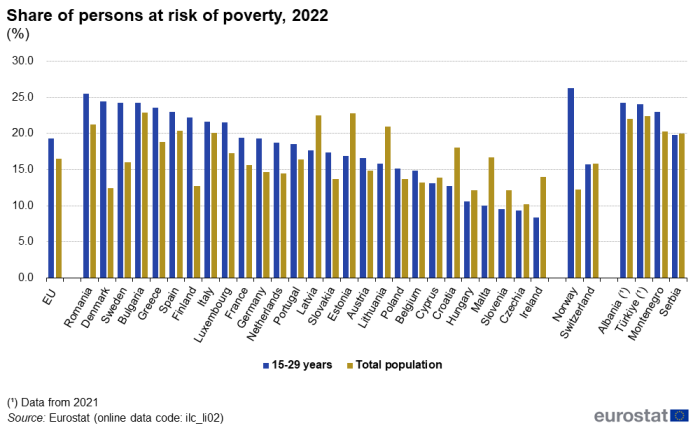Young people - social inclusion
Data extracted in February 2024.
Planned article update: 14 January 2025.
Highlights
In 2022, 17.4 million young people (aged 15-29 years) were at risk of poverty or social exclusion in the EU, of whom 4.1 million were living in severe material and social deprivation.
In 2022, the severe material and social deprivation rate ranged from 1 in 4 persons aged 15-29 years in Romania to less than 1 in 100 persons in Slovenia.
In 2022, the at-risk-of-poverty rate of young people aged 15-29 years was 2.8 percentage points higher than that of the total population.
In 2022, 8.7 % of people aged 15-29 years in the EU lived in households with very low work intensity.
This article presents statistics on the risk of poverty or social exclusion of young people (defined here as those aged 15-29 years) in the European Union (EU), as well as in some EFTA and candidate countries.
Social exclusion at an early age has the potential to have long-lasting consequences for both individuals and society, as it may affect all aspects of young people’s lives. This analysis focuses on an indicator concerning people at risk of poverty or social exclusion and its sub-components — the at-risk-of-poverty rate, the severe material and social deprivation rate and the share of households with very low work intensity between the ages 15 and 29.
Full article
Key findings
In 2022, an estimated 24.5 % of European Union (EU) youth (aged 15-29 years) — or some 17.4 million people — were at at risk of poverty or social exclusion. This rate for young people varied between 37.9 % in Romania and 10.5 % in Czechia.
The risk of poverty and social exclusion is not strictly dependent on a household’s level of income, as it may also reflect joblessness, low work intensity, working status, or a range of other socio-economic characteristics. To calculate the number or share of people who are at risk of poverty or social exclusion, three separate measures are combined, and this covers those persons who are in at least one of these three situations:
• persons who are at-risk-of-poverty, in other words, with an equivalised disposable income that is below the at-risk-of-poverty threshold;
• persons who suffer from severe material and social deprivation, in other words, those who cannot afford at least seven out of thirteen deprivation items (six related to the individual and seven related to the household) that are considered by most people to be desirable or even necessary to lead an adequate quality of life;
• persons (aged less than 65 years) living in a households with very low work intensity, in other words, those living in households where adults worked equal to or less than 20 % of their total combined work-time potential during the previous twelve months.
If we look at the three components of the risk of poverty and social exclusion, in 2022, the at-risk-of poverty rate for young people (aged 15-29 years) in the EU was 19.3 %, while the severe material and social deprivation rate and the rate for people who lived in very low work intensity households stood respectively at 6.1 % and 8.7 %. At EU level, a smaller share of persons aged 25-29 years (an estimated 20.6 % in 2022 at EU level) were at risk of poverty or social exclusion than was the case for persons aged 20-24 years or 15-19 years (26.5 %). Analysed by age group and component, the youngest age group (15–19-year-olds) were the most vulnerable both for the risk of poverty and the material deprivation component (see Table 1). For the share of youth living in households with very low work intensity, the age pattern changes; 25-29 year olds were the most likely to be living in this type of household.

(%)
Source: Eurostat (ilc_peps01n) (ilc_li02) (ilc_mdsd11) (ilc_lvhl11)
Young people at risk of poverty or social exclusion
In 2022, the at-risk-of-poverty or social exclusion rate for young people aged 15-29 years was 24.5 % in the EU, corresponding to about 17.4 million young people. This rate is 2.9 percentage points (p.p.) higher than that of the adult population, considered here to be those 16 years old and over, which stood at 21.6 %.
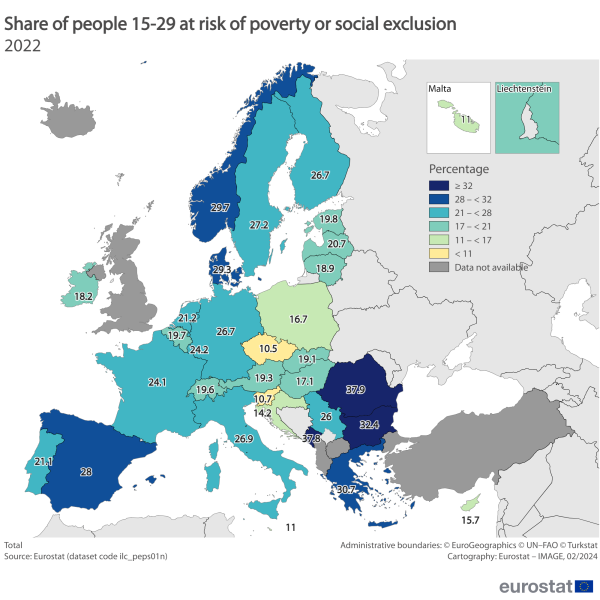
(%)
Source: Eurostat (ilc_peps01n)
In 2022, the EU Member States with the highest levels of young people (aged 15-29 years) at risk of poverty or social exclusion were Romania (37.9 %), Bulgaria (32.4 %) and Greece (30.7 %), while the lowest rates were found in Czechia (10.5 %), Slovenia (10.7 %) and Malta (11.0 %).
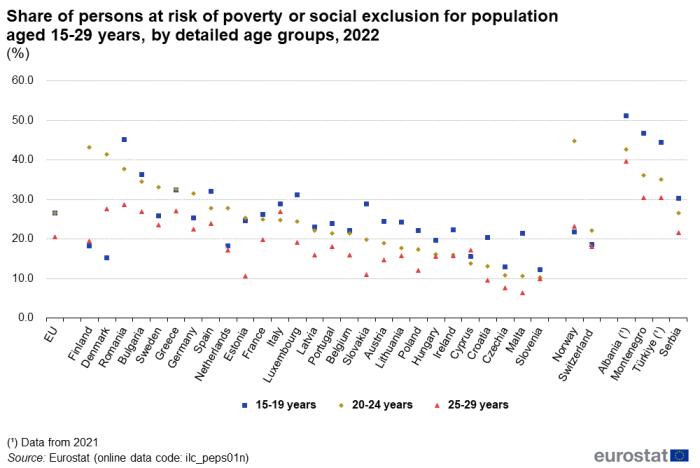
(%)
Source: Eurostat (ilc_peps01n)
In general, a smaller share of persons aged 25-29 years (an estimated 20.6 % in 2022 at EU level) was at risk of poverty or social exclusion than was the case for persons aged 20-24 years or 15-19 years (both at 26.5 %). However, in 19 Member States it was the age category 15-19 years that had the highest risk of poverty or social exclusion. In other Member States, those aged 15-19 years seemed to be less at risk: in Denmark and Finland for example, this age category had the lowest risk, by a relatively high margin (26.2 and 24.9 p.p. difference, respectively, compared to those aged 20 24 years).
At-risk-of-poverty rate of young people
The at-risk-of-poverty rate, a component of the at risk of poverty or social exclusion rate measures poverty in relative terms.
The at-risk-of-poverty rate was at 19.3 % in 2022 for those aged 15-29 years (see Figure 2). At EU level, young people were at a 2.8 p.p. higher risk than the population aged 16 years and over (their rate stood at 16.5 %). This was the case in 17 Member States with the largest gap between the two age groups (15-29 and 16+) observed in Denmark (12. 4% of total population at risk of poverty compared to 24.4 % of young people), Finland (12.7 % compared to 22.2%) and Sweden (16.0 % compared to 24.2 %). However, in 10 Member States young people were less at risk of poverty than the population as a whole. The most noticeable differences were seen in Malta (16.7 % compared to 10.3 %), Estonia (22.8 % compared to 16.9 %) and Ireland (14.0 % compared to 8.4 %).
Severe material and social deprivation of young people
The severe material and social deprivation rate complements the relative poverty indicator (which is based on income) by taking account of non-monetary resources. It is therefore based on a single European threshold. It is an absolute measure of poverty, which captures the differences in living standards between EU Member States. In 2022, the severe material and social deprivation rate for young people (aged 15-29 years) in the EU stood at 6.1 %, while the share for the total population was 6.7 %. We can observe that for this indicator the share of young people was smaller than that of the total population. Exceptions include Romania, Greece, Sweden, Finland and Germany by a small margin. Among the EU Member States, in 2022 the highest proportion of young people (aged 15-29 years) who were severely materially deprived was observed in Romania (25.4 %), followed by Bulgaria (18.6 %) and Greece (14.9 %). Less than 3.0 % of young people were severely materially or socially deprived in 12 Member States — see Figure 3.
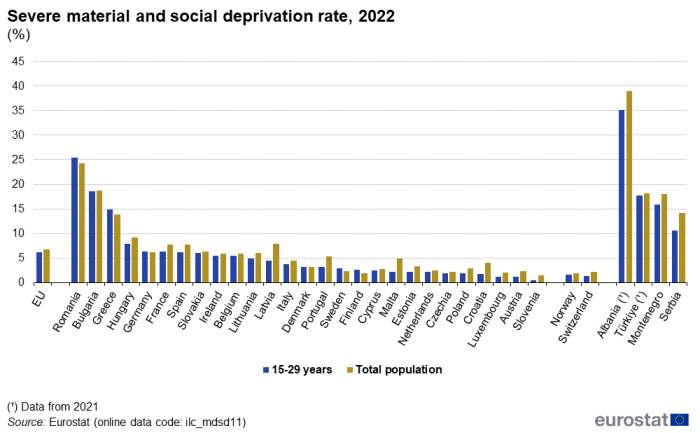
(%)
Source: Eurostat (ilc_mdsd11)
The analysis of severe deprivation rates according to the age group of young people (see Figure 4) reveals that in general the differences between the age groups are smaller than in the case of the at risk of poverty. In slightly over half (fourteen) of the Member States, the most deprived category was the youngest (aged 15-19 years), which was also the case at EU level (6.7 % in 2021, compared to 5.9 % for those aged 20-24 years and 5.8 % for those aged 25-29 years).
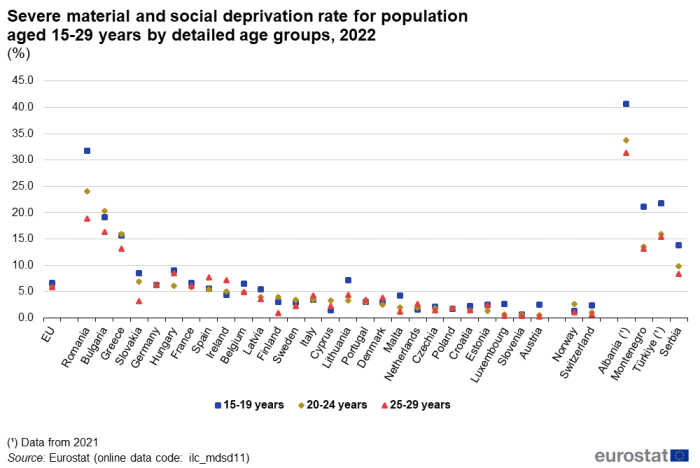
(%)
Source: Eurostat (ilc_mdsd11)
Young people living in households with very low work intensity
Another component of the at risk of poverty or social exclusion rate is defined as living in households with very low work intensity. People living in such households are more likely to be exposed to social exclusion.
In 2022, 5.9 million people aged 15-29 years in the EU lived in households with very low work intensity, equivalent to 8.7 % of the population of this age group — see Figure 5. Among the EU Member States, Denmark (14.4 %), Finland (13.7 %) and Belgium (11.4 %) recorded the highest proportions of people aged 15-29 years who lived in households with very low work intensity in 2022. The lowest proportions were registered in Malta (1.8 %), Poland (2.9 %) and Slovenia (3.7 %).
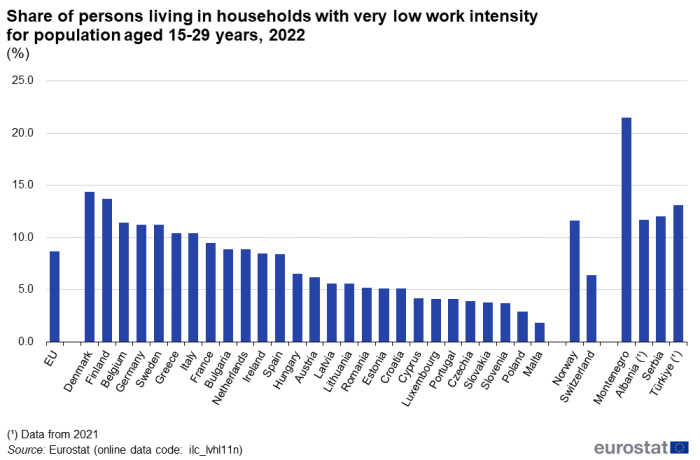
(%)
Source: Eurostat (ilc_lvhl11n)
Source data for tables and graphs
Data sources
The data used in this article are derived from EU statistics on income and living conditions (EU-SILC). The legal basis for these data is the framework Regulation No 2019/1700-- Common framework for European statistics relating to persons and households, based on data at individual level collected from samples. The EU-SILC is the main European source of information for statistics relating to income, living conditions and social inclusion. The reference population covered by these data is all private households and their current members residing in the territory of an EU Member State at the time of data collection. Persons living in collective households and in institutions are excluded from the target population. The EU aggregate is a population-weighted average of individual national figures.
Context
On 25 June 2021, the European Council welcomed the EU headline targets of the European Pillar of Social Rights Action Plan, in line with the Porto Declaration. One of its three headline targets is the reduction of poverty: the main aim is to lift 15 million people out of risk of poverty or social exclusion by 2030, out of which 5 million should be children.
Social inclusion was one of the eight fields of action in the EU Youth Strategy which ran from 2010 to 2018. In May 2018, the European Commission put forward proposals for a new EU youth strategy for the period 2019-2027, where 'Inclusive society' is one of 11 goals. The new youth strategy has been adopted in 2021.
Direct access to
Theme entry page
Online publications
Statistical articles
- Youth (yth), see:
- Youth social inclusion (yth_incl)
- People at risk of poverty or social exclusion (Europe 2020 strategy) (ilc_pe)
- Main indicator - Europe 2020 target on poverty and social exclusion (ilc_peps)
- Income distribution and monetary poverty (ilc_ip)
- Monetary poverty (ilc_li)
- Living conditions (ilc_lv)
- Population structure (ilc_lvps)
- Health and labour conditions (ilc_lvhl)
- Material deprivation (ilc_md)
- Material deprivation by dimension (ilc_mddd)
Notes
1. Households composed only of children, of students aged less than 25 years and/or by people aged 64 years or more are excluded from the computation of this indicator (for both the numerator and denominator). Students aged 18-24 years who live with at least one other person of working age who is not a student are excluded from the computation of the household work intensity, but they are given the household work intensity computed on the basis of the other household members. The same rule applies for children.

